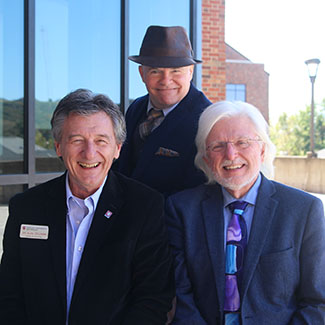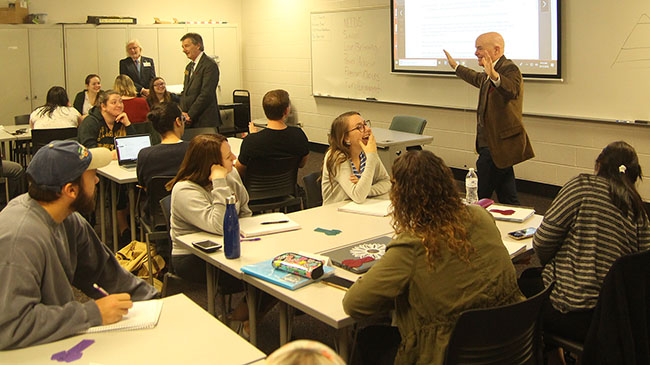
By Steven Krolak
(NEW ALBANY, Ind.)–If teaching and learning were jazz, it would look and feel a lot like the classroom of Alan Zollman, Bradford Griggs and David Sullivan-Losey.
The three colleagues in the School of Education teach general methods, a class that is accepted grimly as part of the teacher prep territory—like earthquakes and fires in California or tornadoes and great big creepy bugs in Texas. It’s where teacher candidates learn about classroom management, school law, lesson planning, discipline, and other non-tantalizing topics. In the hands of this inventive trio, however, the drudgery is transformed. The instructors lay down the basic agenda for the day’s lesson, then start to move around the room, make points, riff off one another, ask questions, make a joke, share an anecdote, follow a tangent, disagree, amplify, challenge. They divide the class into groups, then role-play a situation that emerged from discussion, reshuffle the groups, and discuss again.
The agenda is still there—best practices, evidence-based research, Maslow’s hierarchy of needs, war stories from the pedagogical trenches–but it’s barely recognizable, because it has morphed into some new syncopated synthesis, with a beat driven not by the metronomic drone of the outline, but by the attentiveness and engagement of the candidates.
In the hands of Zollman, Griggs and Sullivan-Losey, instruction is not about executing a time-honored game plan, but about launching improvisation, exploration and self-realization.
A different kind of soup
Like many inventions, this one started in necessity: When Griggs took a medical leave, Zollman and Sullivan-Losey agreed to cover his class. They came up with some pretty good hacks, such that when Griggs returned, he found a class that did not need fixing, and simply added his own voice to the song his colleagues had created.
Together, the three colleagues continued to refine their approach, based partly on the research around team-teaching and partly on their own experience, which is considerable.
“It’s like we’re 130 years old,” Griggs said of their combined teaching dotage.
Their experience isn’t only deep, but broad, extending across the major content areas—Griggs and Sullivan-Losey are rooted in social studies and language arts, Zollman in mathematics and science.
Rather than fostering civil war, that diversity proved to be a positive.
“We have separate experiences that blend very well together,” Zollman said.
That blend helps candidates develop a more nuanced mindset.
For activities in other classes, candidates are frequently divided up into groups according to their content areas; but groups in this class are more flexible, with math and language arts students working together on lesson plans and classroom management.
The benefits are many. First, candidates are forced to confront a level of complexity they are likely to encounter in their profession.
“In real life classrooms, problems don’t present themselves in isolation,” Griggs said.
In addition, they learn to work with and benefit from different points of view, which will help them collaborate with colleagues from different areas, and find inspiration in new places.
“Mathematical process-based thinking is different from philosophical thinking,” Griggs said. “When you put the two together, you get a whole different kind of soup.”
As a result of that soup, class evaluations went from so-so to rock star.
Prof. Kevin Sue Bailey, who taught the next level secondary English course, noticed a change in the performance of the candidates coming into her class. They were no longer afraid of lesson planning, but approached it with creativity and enthusiasm, according to Losey.
“She was the first to recognize that this was working more efficiently and effectively than before,” Losey said. “She encouraged us to keep doing it and nurturing it.”
From teachers to facilitators
And so they did. Now seven years in, the team has its shtick down.
It begins with a fundamental consensus.
“We seriously believe that all students can learn,” Griggs said.
It sounds obvious enough, but in fact, it’s a 180 degree departure from traditional teacher-training practice, which focuses on the instructor, not the student, and presumes that if the desired outcomes are not achieved, it is because students are unteachable.

It’s also a radical change from the way that Zollman, Griggs and Sullivan-Losey were trained.
“We were told that to be a teacher meant having very good notes and transferring those notes to your students’ notes, and bypassing everybody’s thinking,” Zollman said.
Their method stresses thinking: constant awareness of student learning, sensitivity to where students are coming from, reflection, and the necessity of being able to regroup, change. It’s about building relationships with students, building cognitive routines, modeling reflective learning so that students will become reflective learners.
“Research shows that really good teachers go from being a teacher to being a facilitator of learning,” Zollman said. “It’s a different philosophy.”
In this approach, the seemingly mundane aspects of classroom management and lesson planning assume outsized importance, because they create the learning environment, and establish the foundation for the relationship to come.
The important thing is to plan and manage from an inclusive and realistic standpoint.
In fact, the word “reality” plays a large role in their method.
When they share experiences from the their years in schools, it’s not just for effect. It’s to contextualize the more theoretical material, put it up for discussion, and ground it in today’s working environment.
“It’s our mission to help candidates understand what it is they’re getting into,” Griggs said.
Part of that mission is handled by Losey, who makes sure that candidates still meet their sizable administrative requirements–like CPR certification—while undergoing the larger paradigm shift.
Another part is delivered through the sharing of real life stories—those 130 years of teaching contain just about every situation students are likely to encounter, from dealing with F-bombs to navigating a lawsuit.
Yet more of the mission is devoted to structured professional development that brings superintendents from area school corporations to campus for mock job interviews. Candidates learn not only to field questions, but to advocate for themselves, and to find the right fit for their teaching methods and goals, all of which demands a significant level of self-awareness.
“School can be beautiful and wonderful, but if you don’t like the people you work with, you won’t last,” Zollman said. “On the other hand, you can be in a tough school, but if everyone has the same mentality and approach to teaching and learning, it can be incredibly enjoyable.”
The final part is administered subliminally, through modeling of technique and temperament. This is surely the most electric, illuminating, entertaining, memorable part.
But Zollman, Griggs and Sullivan-Losey aren’t just trying to administer the proverbial spoonful of sugar. They are demonstrating what teaching can look like.
“When candidates are out in the classroom, they’re not just there to observe or practice, they’re there to actually co-teach, to be a knowledgeable pair of hands in the classroom that helps the teacher,” Zollman said. “I think we’re a good model of how you can co-teach, even though you come from different backgrounds.”
It’s hard to chart outcomes, but it’s interesting to note that 85 percent of IU Southeast School of Education graduates are still teaching after five years, compared to 44 percent nationally.
One model, one follow
What do you do when you have a hit? In music, you take it on the road.
In academia, you publish.
Early on in their collaboration, when Zollman, Griggs and Sullivan-Losey were plumbing the literature for relevant insights, they found a lot of information about team-teaching in the realm of special education, but literally nothing in the teacher-training field. They have since filled that vacuum with their own findings.
Beginning in 2016, they have published four scholarly articles on the success of the model they call “one model, one follow” in peer-reviewed journals.
Their approach is replicable, scalable and, best of all, relevant.
In today’s classroom, standardized testing not only dominates the students’ learning experience, but can also determine the longevity of an instructor’s career and the funding status of the entire school. With so much riding on the outcome, with every minute of every day is important in light of looming exams, established classroom teachers aren’t eager to put let a candidate borrow the keys to the family car, so to speak.
This is where the “one model, one follow” model is most effective.
It replaces the traditional scenario—in which the classroom teacher hands over her class to a green student-teacher, who panics, fails, succeeds or more likely does all three in a traumatic vortex of conflicting emotions that makes her question her life choices while the classroom teacher returns to wean her pupils off the sugar-high of absolute power they have enjoyed and abused—with a more collaborative model. The lesson plan is co-developed, then the classroom teacher presents it, the student teacher observes and assists, then the roles are reversed for a few classes. The classroom teachers don’t need to leave the room, and can reap benefits from co-planning and co-teaching.
In the process, the classroom is transformed from a task-fulfillment center into what Zollman has described as “a collaborative community of learners, where students are expected to understand their roles and their responsibilities to the instructor, to themselves, and to their peers.”
Restoring agency
Zollman, Griggs and Sullivan-Losey speak from the heart, and from experience. Each arrived at the doorstep of innovation via disillusionment with traditional methods that left them feeling unsuccessful in their careers and unfulfilled as human beings. By restoring agency and creativity to the art of instruction, they work to inspire future generations of teachers to embrace both the challenge and the glory of the teaching life.
“They come in thinking that it’s just a class,” Zollman said. “We try hard to show them that this isn’t just a class, it’s a profession.”


